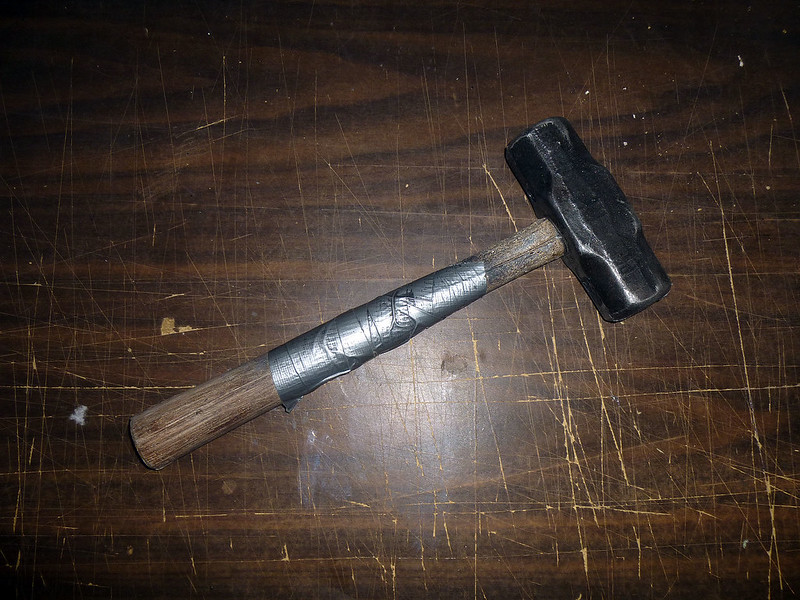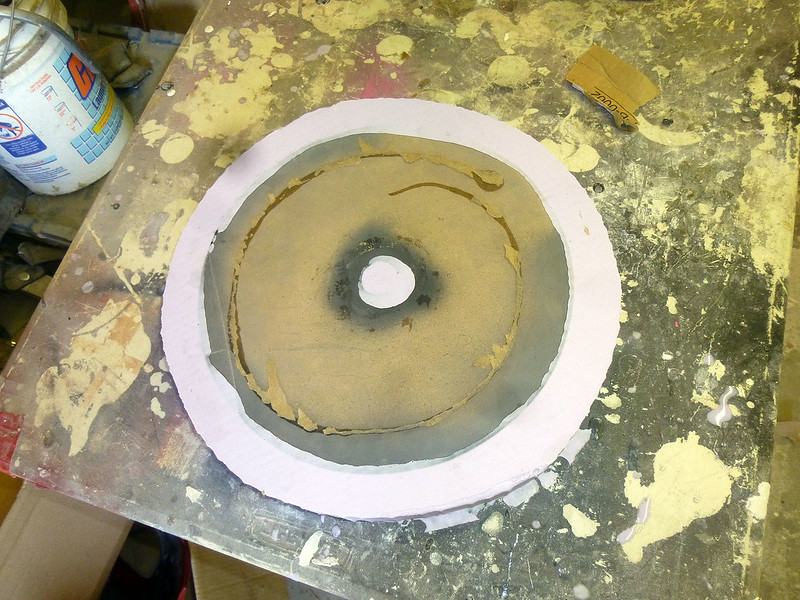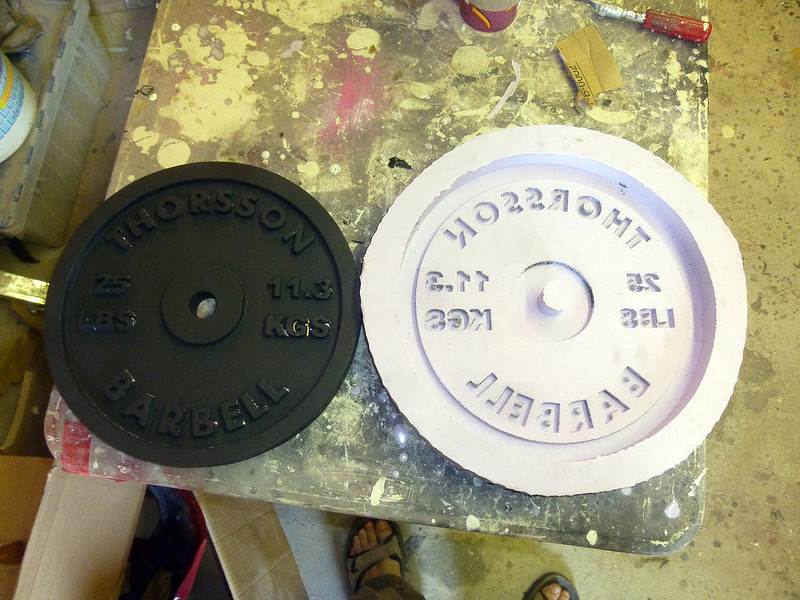In this article I'm going to detail the process of making a 2-piece silicone mold. The same
methods can be used mold and cast all manner of things with details on
both sides. If you're looking to make a mold of something flat that has
no details on one side, check out my last "Prop Building 101" article,
"Making a One-Sided Silicone Mold."
For the purpose of this demonstration I will be making molds to copy a few hammers.
Hammers are hard and heavy. One of the basic tenets of society is that throwing hammers at your friends will rapidly result in not having friends.
But what if you want to keep your friends and you can't resist the urge to throw hammers at them? Well my friend, you've come to the right place. Here's how to simulate a variety of typical, run-of-the-mill hammers with soft, pliable, non-concussion-inducing flexible foam.
Here's a picture of a fully-finished foam rubber hammer:

If you'd like to know how to make one, read on...
A while back, the folks at MAKE Magazine asked me to do a quick moldmaking demonstration as part of their "Maker Camp," a virtual summer camp program conducted via Google+ Hangouts. I was happy to oblige. I usually have a handful of simple projects on my get-around-to-it list and this was an excuse to knock a couple of them out.
The first type of mold I demonstrated was a one-sided mold occasionally referred to as a "block mold." This is the type of mold you make when you need to replicate something with a flat side that has no details. When laid on that side, the piece has to have no significant undercuts where bubbles will be trapped.
I decided that the perfect candidate for reproduction would be a simple barbell plate. I started by carving out a quick prototype on my CNC machine:
 Here it is after a light sanding:
Here it is after a light sanding:

I gave it a couple of coats of primer to seal up the surface and then it was time to set it up for molding.
First, I glued it down to a piece of cardboard so it wouldn't float away once I poured silicone over it. Then I used more cardboard to glue together a watertight wall around the plate with an approximate standoff of one inch.
Here's a shot of the painted prototype with mold box built around it:

After double-checking to be sure that the box wouldn't leak, I mixed up a batch of silicone RTV moldmaking rubber and began pouring:

When pouring the rubber, it's a good idea to start pouring into a low part of the mold. This way the rubber will flow up and over the part in the mold without trapping as many bubbles against the surface of the part.
After filling the mold box so that there was at least 1/2" of silicone over the top of the part, I left it overnight to cure. You want that half inch of rubber so that any bubbles will have a chance to rise up and away from the surface of the piece you're replicating. Any bubbles in the rubber now will become warts on the copies when it comes time to make castings.
Once the rubber had completely cured, the next step was to flip the mold over and remove the cardboard:

With the cardboard peeled off, you can peel the rubber off of the prototype:

To make a copy of the prototype, it's just a quick matter of filling the silicone mold with a lightweight casting resin or expanding foam:

Depending on the quality of the silicone rubber you use, you can get anywhere from twenty to sixty castings out of a mold like this.
While it looks just like any other 25-lb barbell plate, this particular casting weighs about 4 ounces. It makes it look like I have really strong fingers:

Since I cast this particular plate in flexible foam, it'll bounce when you throw it at someone.
Fun!
The Ten Pound Bag of Pennies.
This is the history (so far) of an eleven-year running joke.
I went to a college designed to train sailors for the Merchant Marine. So in addition to a very full academic curriculum, every summer after final exams, the whole campus would move onto the training ship Empire State VI and steam around the North Atlantic. The first time I went on one of these cruises was 1996.
I had just finished my freshman year in college and my friend Rich had decided to change majors so that he could avoid the maritime license portion and wouldn’t be obligated to go on these cruises. The night before I got underway I returned to my berthing space (there were 97 of us living in one room) to find a milk crate sitting on my bunk. It was filled with some of the most useless crap you could bring on a ship. This included a power outlet strip, a handful of odds and ends, and, most notably, a ten pound bag of pennies.
As a first year cadet at the maritime college I was entitled to very little real estate in the berthing spaces. In fact, I had my bunk to sleep in and a standing locker right around the corner. So when nobody was willing to admit ownership of the crate in question it took me some creative repacking to integrate this milk crate into my very limited living space.
The next morning, Rich came down to the pier to see me off. We chatted about the summer job he was taking and where I’d be going before he rather offhandedly asks me if I got the crate of stuff he’d left me.
“That was you?” I asked.
“Yeah, I couldn’t find room in storage for that stuff and I thought you might be able to use it.”
“Really?” says I, “There was nothing useful at all in there.”
“It’s all useful stuff,” says he, “there’s even some money in there.”
“What the hell am I going to do with a ten pound bag of pennies?”
“I figured you would need the money in Europe.”
I proceeded to explain to him that there’s no currency exchange in the world that accepts coins, not to mention pennies. In fact, even the ship’s store had posted a sign stating that they would not be taking pennies or giving them in change. Quite frankly there would be no use for ten pounds of pennies unless I was going to attempt suicide by overdosing on copper.*
So I spent the next two months with a ten pound bag of pennies under my pillow. When we returned to our home along the Bronx side of New York’s aromatic East River, Rich was there to meet me.
“Hey,” says I, “How would you like a ten pound bag of pennies.”
“No thanks,” says he, “You never know when you’re going to need the money.”
There were at least four other occasions over the next four or five months when I tried to give him this very same ten pound bag of pennies. Then along comes his birthday. This particular year he got a coin rolling machine for his birthday. So he does the first logical thing anybody would do in his situation. He goes to visit the guy who has been trying for months to give him a ten pound bag of pennies. He explains how easily he’ll be able to return these pennies to circulation and how he’d be willing to split the proceeds if I’d help him roll the coins.
After he told me all about this simple scheme to make a ten pound bag of pennies into actual folding money, I said the only thing I could say:
“Fuck you.”
By my reasoning, I had already tried on several occasions to return this ten pound bag of pennies to him and on each of these several occasions he refused. This means that it was now my ten pound bag of pennies and it was up to me to dispose of them as I saw fit. Furthermore, since it was good enough for him to cause a ten pound bag of pennies to be a minor nuisance to me for a number of months, I could only do well to return the favor.
Fast forward two and a half years.
I had just graduated and was working at the Naval ROTC office on campus for a few weeks before being transferred to Rhode Island with the Navy. Rich had re-evaluated his earlier decisions and found himself stuck going out on the training ship to catch up on his final training cruise. So the night before the ship set sail, I stole aboard and stealthily slipped the self same ten pound bag of pennies into his pillowcase while he was on watch.
The next morning he asked me what he was supposed to do with them.
I quaked with unfeigned mirth.
The ten pound bag of pennies found their way into my life again within about four months. I was a student at the Surface Warfare Officer School (SWOS) in Newport, Rhode Island. One day in the mail I received a parcel containing a bright orange US Army athletic shirt, a bright orange pair of US Army swim trunks (size XXL), and the ten pound bag of pennies. Cute.
So after I finished at SWOS and Rich had started, I stopped at the US Coast Guard training center just outside Petaluma to do some shopping. I sent Rich a USCG sweatshirt and coffee mug, a teddy bear in a Coast Guard Uniform, and the very same ten pound bag of pennies. Of course, I made it a point to send it to him at the school so that he’d have to open it with all of his Navy classmates around. Cuter.
Since then the ten pound bag of pennies has changed hands many times. Occasionally by mail, but more often by being planted in each other’s cars or homes or luggage during visits. I suppose in a lot of ways this whole story would be a lot more entertaining if it could be told accurately from the point of view of the ten pound bag of pennies. Some of the exchanges have been pretty entertaining.
Most notably there was an occasion when I had surreptitiously hidden the ten pound bag of pennies in Rich’s laptop case not long before he and his entire family were to board a plane for a cross-country flight. While waiting in line for a security checkpoint, Rich’s wife Barbara found the ten pound bag of pennies. As she pulled it from the laptop case, the ten pound bag of pennies burst, showering the concourse with ten pounds of pennies. Rich was in the bathroom at the time. I can only imagine the scene of apparent poverty he met when he walked out to find his wife and two children scrambling frantically to scrape ten pounds of pennies off the floor in the airport. I don’t know how much a ten pound bag of pennies is worth, but that scene would have been priceless.
The last couple of exchanges had Rich or his wife or one of his kids (he’s got the whole team to help him now) hiding the ten pound bag of pennies very cleverly in my dive bag. Then me not-so-cleverly hiding the ten pound bag of pennies in the center console of their Lincoln Navigator when they left town to put it in storage for their tour overseas. Then them discovering the not-so-cleverly hidden ten pound bag of pennies in the center console and condescendingly depositing it in the mailbox at the end of the driveway where I couldn’t possibly miss it or return it.
The next time I saw Rich was over seven months later when I happenned to visit him and his family in Japan where the Navy had stationed him. I didn't have the pennies with me, but that didn't stop him from tearing his house completely apart searching for them after I'd departed. To this day he doesn't believe me when I tell him I didn't have them with me.
It's been quite a few months now and I'm still stuck having to find a clever way to get the ten pound bag of pennies to somehow pop back up in Rich's life. At this point it's starting to look like I'll either have to fly to Japan without him knowing or I'll have to enlist the help of my network of navular friends. One of us will finally win this game when he clandestinely places the ten pound bag of pennies in the other’s coffin. Fortunately, Rich is just a bit older than me…
Stay tuned.
*This won’t work by the way. Modern pennies are made mostly from zinc. If you want to find out whether or not you can overdose on copper, you’ll have to get it somewhere else.









